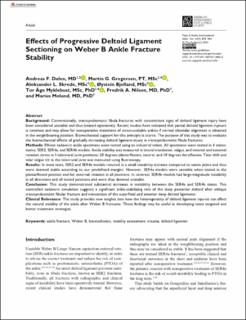| dc.contributor.author | Dalen, Andreas F. | |
| dc.contributor.author | Gregersen, Martin | |
| dc.contributor.author | Skrede, Aleksander Larsen | |
| dc.contributor.author | Bjelland, Øystein | |
| dc.contributor.author | Myklebust, Tor Åge | |
| dc.contributor.author | Nilsen, Fredrik Andre | |
| dc.contributor.author | Molund, Marius | |
| dc.date.accessioned | 2024-02-21T14:15:52Z | |
| dc.date.available | 2024-02-21T14:15:52Z | |
| dc.date.created | 2023-08-30T11:43:36Z | |
| dc.date.issued | 2023 | |
| dc.identifier.citation | Foot & ankle international. 2023, 44 (9), . | en_US |
| dc.identifier.issn | 1071-1007 | |
| dc.identifier.uri | https://hdl.handle.net/11250/3119087 | |
| dc.description.abstract | Background:
Conventionally, transsyndesmotic fibula fractures with concomitant signs of deltoid ligament injury have been considered unstable and thus treated operatively. Recent studies have indicated that partial deltoid ligament rupture is common and may allow for nonoperative treatment of stress-unstable ankles if normal tibiotalar alignment is obtained in the weightbearing position. Biomechanical support for this principle is scarce. The purpose of this study was to evaluate the biomechanical effects of gradually increasing deltoid ligament injury in transsyndesmotic fibula fractures.
Methods:
Fifteen cadaveric ankle specimens were tested using an industrial robot. All specimens were tested in 4 states: native, SER2, SER4a, and SER4b models. Ankle stability was measured in lateral translation, valgus, and internal and external rotation stress in 3 talocrural joint positions: 20 degrees plantarflexion, neutral, and 10 degrees dorsiflexion. Talar shift and talar valgus tilt in the talocrural joint was measured using fluoroscopy.
Results:
In most tests, SER2 and SER4a models resulted in a small instability increase compared to native joints and thus were deemed stable according to our predefined margins. However, SER4a models were unstable when tested in the plantarflexed position and for external rotation in all positions. In contrast, SER4b models had large-magnitude instability in all directions and all tested positions and were thus deemed unstable.
Conclusion:
This study demonstrated substantial increases in instability between the SER4a and SER4b states. This controlled cadaveric simulation suggests a significant ankle-stabilizing role of the deep posterior deltoid after oblique transsyndesmotic fibular fracture and transection of the superficial and anterior deep deltoid ligaments.
Clinical Relevance:
The study provides new insights into how the heterogenicity of deltoid ligament injuries can affect the natural stability of the ankle after Weber B fractures. These findings may be useful in developing more targeted and better treatment strategies. | en_US |
| dc.language.iso | eng | en_US |
| dc.publisher | SAGE Publications | en_US |
| dc.rights | Navngivelse-Ikkekommersiell 4.0 Internasjonal | * |
| dc.rights.uri | http://creativecommons.org/licenses/by-nc/4.0/deed.no | * |
| dc.title | Effects of Progressive Deltoid Ligament Sectioning on Weber B Ankle Fracture Stability | en_US |
| dc.title.alternative | Effects of Progressive Deltoid Ligament Sectioning on Weber B Ankle Fracture Stability | en_US |
| dc.type | Peer reviewed | en_US |
| dc.type | Journal article | en_US |
| dc.description.version | publishedVersion | en_US |
| dc.source.pagenumber | 0 | en_US |
| dc.source.volume | 44 | en_US |
| dc.source.journal | Foot & ankle international | en_US |
| dc.source.issue | 9 | en_US |
| dc.identifier.doi | 10.1177/10711007231180212 | |
| dc.identifier.cristin | 2170881 | |
| cristin.ispublished | true | |
| cristin.fulltext | original | |
| cristin.qualitycode | 2 | |

